
This year marks the 10th anniversary since the Belt and Road Initiative (BRI) was launched. In the past decade, over 150 countries and 30 international organizations have signed up to the initiative. With an overall investment of over one trillion dollars, there have been more than 3000 projects in place, fostering the creation of over 400,000 jobs for people in participating countries. Despite these achievements, the BRI has run into some doubts and, at times, even negative reporting, particularly by some Western media.
To debunk the myths about the BRI and depict the true picture of the BRI projects, CGTN cohosted a special event: “Belt & Road: When dreams have wings,” the first ever on-site edition of the China Talk program, together with Renmin University of China.
The guest speakers included Mr Djoomart Otorbaev, former prime minister of Kyrgyzstan; Charles Liu, founder of Impact Asia Innovation Capital; Zhang Jianyu, executive director for the BRI Green Development Institute and Zoon Ahmed Khan, researcher of the Center for China and Globalization.
They gave speeches on the history, present development, and future vision of the BRI. And what’s more, they had a heated discussion on the headwinds the BRI ran into.
Citing the name of the event, Mr. Djoomart Otorbaev says with better connectivity brought about by the BRI, Central Asia can once again relive its historic glory and realize its dream to become the hub of trade, investment, commerce, and exchange of ideas.
Responding to accusations that China is using the BRI as a means of economic coercion and a debt trap, Charles Liu rebuts that these projects have brought concrete benefits to participating countries. He says no developing countries can be coerced into building infrastructure essential to their development, adding China’s experience in alleviating poverty and realizing common development can be of help to other developing countries.
Zhang Jianyu explains that despite challenges, great strides have been made in greening the BRI projects. One example is the Nairobi-Mombasa Railway, which the Kenyan government recognized as one of the low-carbon contributions the country has made to the global effort to counter climate change. He says the BRI shows China’s commitment to building a shared future for all humankind.
Zoon Ahmed Khan defines the BRI as a pragmatic approach to development, with a focus on trade, not aid. She believes that the BRI stands for unity, not uniformity, which has brought change to the lives of people of participating countries, and given voice to what she calls “the silent majority of Global South,” about 80 percent of the world population.
Over 100 students from more than 20 countries also took part in the event. During the Q&A session, they had an engaging discussion with the guests, to address issues including the financing of the BRI and how participating countries can realize green and sustainable development at the same time.